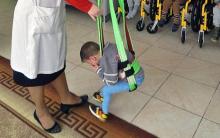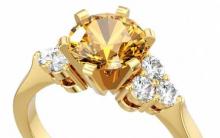Svetlana Legina
Subject: « Balloon»
Program tasks:
Teach children to draw round objects (ball); distinguish colors, name them correctly; hold the brush correctly and type paint on a brush, dipping it with all the lint into the jar, remove excess paint, touching the lint to the edge of the jar.
Develop children's aesthetic perception,
Cultivate children's interest in drawing.
Equipment and materials:
Demo material: bear, burst balloon red, inflated air balloons according to the number of children
Handout: album sheet, gouache, brushes.
Progress of the lesson:
Guys, shhh, do you hear, someone knocked on our door. Sit quietly, I’ll go and see if anyone has come to visit us?
Kids, look who came to us. Who is this? (Bear). Look, he's crying. Let's ask him why he's crying? (Yes). Bear why are you crying?
Guys, I went to the hare for his birthday, carrying balloon as a gift, caught on a twig in the forest and the balloon burst, what to do? Don't know….
Let's calm the bear down and play a game « Ball»
FINGER GAME « BALL»
Fast inflate the balloon
He's getting big
Suddenly the balloon burst
The air has escaped,
He became thin
Guys, do you love paint? (Yes). Guys, let's draw a bear balloons. What was he like? the bear has a ball? (round, red)
What colors are there? balloons? (red, yellow, etc.) That's right guys our balls are colorful
DISPLAY WITH EXPLANATION
Showing how we will draw our balls.
I take the brush in my hands, above her clothes. Now I’ll dip the brush in paint. . I take the green one paint and I begin to draw a rounded line and connect one end to the other. And I paint over it with a light movement.
It turned out ball?
Now I'm drawing a line. This will be the rope ball.
Here it is green ball.
And now the guys raised their tassels. We spend everything together in air rounded line. We connect one end to the other, so that we get ball. AND draw a string line to the ball.
Well done!
We hold the brush with three fingers, with our right hand.
Now dip the brush in paint. You need to paint carefully. Like this. Now let's draw rounded lines so that one end connects to the other. All drew? And now light movements paint over the hands balloons. Try not to go outside the circle. Let's try to our balls turned out beautiful, and the bunny will walk and watch how you can beautiful to draw.
FINAL PART (with a bear)
The bear told me what everyone's you get beautiful balls. Well done!
Guys, you see how the bear praises you, he even stopped crying.
Thank you guys for these balloons! Now I'm going to go to my birthday party, how happy my friend the bunny will be! Goodbye, guys! (Goodbye).
You guys all did great today. I have prepared it for you balloons, play with them.


Publications on the topic:
GCD form: visual activity- application. Educational field: artistic and aesthetic. Form of organization: subgroup.
Municipal educational institution Kladovitskaya basic comprehensive school Summary of directly organized activities.
Summary of educational activities for cognitive development in the middle group “Balloon” Goal: to generalize children’s ideas about air and its properties, promoting the formation of cognitive interest. Objectives: Educational:.
Summary of a lesson on painting with watercolors "Cosmea" in the senior group Lesson notes in senior group for drawing “FLOWERS” (cosmea) Tasks: Continue to introduce watercolor paints, teach ways of working.
"Aerial mode of transport - hot air balloon." Lesson notes on artistic creativity (application) Lesson on the application “Air mode of transport - balloon" Goal: To teach children to create an air transport from paper. Tasks:.
Summary of a lesson on non-traditional drawing in the middle group Topic: “Space” (drawing with dough or 3D paints) MDOU " Kindergarten“Birch” Lesson notes on unconventional drawing V middle group Topic: “Space” (drawing with dough or 3D paints).
Subject:“Drawing using the technique of printing with balloons “Christmas tree toys.”
Target: Formation of skills for interaction between parents and children through creative activities.
Tasks:
- Developmental:
Development of fine motor skills, color perception, tactile perception, imagination.
Development creativity children, interest children in unconventional ways drawing.
Develop interest in unconventional images on paper.
- Educational:
Improve the skills of non-traditional image of an object (a print of a balloon on paper).
- Educational:
Cultivating aesthetic taste and work culture
Cultivate accuracy when working with paints.
To cultivate attention and perseverance in children;
Methods used:
Verbal: guessing riddles, teacher's story.
Practical: finger gymnastics“We went for a walk in the yard.”,
Equipment: landscape sheets of paper for each child, gouache in red, yellow, blue, green colors, slightly inflated balloons, hand napkins, tape recorder, audio recording: “Christmas tree, Christmas tree - forest scent” Words by I. Shaferan, music by O. Feltsman
Integration educational areas:
"Artistic and aesthetic development."
Preliminary work: looking at illustrations of New Year's holiday, conversations, reading poems about the New Year.
Progress of the lesson.
1. Surprise moment.Balloons appear, with envelopes with riddles for children tied to their threads.
- Look what a miracle it is! Bright balloons flew to our group. And what is tied to the threads? Let's read it! These are riddles.
We bought a hanger
With a star on top of the head.
Hung on a hanger
Not hats, but toys!
(Christmas tree.)
In winter, during fun times,
I'm hanging on a bright spruce
There will be a Christmas tree in the corner
At the window on the floor.
And on the tree to the top
Multicolored...
(Toys.)
Round like a ball
Shines like a flashlight
Only he doesn’t jump -
Very fragile... (Ball)
- What do you think our event today is about? (New Year, Christmas trees, Christmas tree decorations...)
- Do you know what they are made of? Christmas decorations? (Plastic, glass, paper, fabric)
- At first, Christmas tree decorations were only edible: eggs and waffles swayed on the branches next to fruits, sweets and nuts. It is believed that it was the failure of the apple harvest that forced Christians to show their imagination and find a replacement for them in the form of other Christmas tree decorations. The first decorations were replaced by crafts made of paper and cotton wool, foil and tin wires.
Also, toys were made from cardboard; there were also toys from cotton wool wound onto a wire frame: this is how figures of children, angels, clowns, and sailors were decorated.
However, it is impossible to imagine christmas tree no glass toys and, in particular, no balls.
- Listen to the poem:
Decorated a lush Christmas tree
Blue large painted ball.
Nearby on a branch shone with beauty
The ball is also painted gold.
Both were shining with important drawings:
The Christmas trees sparkled on each ball.
(Tatiana Lilo)
2. Show
- Today we will draw Christmas balls. Just what are we going to draw with, since we don’t have brushes or pencils?
- Now you and I will turn into wizards... we will draw in an unusual way- balloons. We will not just draw, we will put an imprint on a piece of paper balloon.
-Take the ball by the tip and dip it halfway into a plate of paint. Place the ball on a sheet of paper perpendicularly, holding it by the tip. We tilt the ball up and lightly press it against the paper, then remove it. In the future, apply it in any direction, with the painted side, rotating around its axis.
During the drawing process, you can change or add color, details (spruce branches, strings for balls, background, etc.) can be completed with a brush.
-Now, let's stretch our fingers.
3.Finger gymnastics
“We went for a walk in the yard.”
One, two, three, four, five, (Bend fingers).
You and I made a snowball. (Children “sculpt”).
Round, strong, very smooth (Show a circle, clench your palms, stroke the other with one palm).
And not at all sweet. (They shake their finger).
Once - we'll throw it up, ("They'll throw it up").
Two - we'll catch it, ("They're catching").
Three - let's drop ("Drop").
And... we'll break it.
(Cooperative activity children and parents. Children draw to the music (“New Year! Christmas tree, balls, firecrackers”, performer Lera)).
The teacher conducts individual work and helps as needed
4. Job analysis.
- Admire how beautiful and unusual the balls we have turned out to be!
- How did we draw them?
- What do you think our Christmas tree decorations turned out to be?
- What did you like to draw most?
- Guys, you are all so great! What wonderful Christmas tree decorations you have!
5. Summary of the lesson.
- Our lesson is over. Were you interested?
- What do you remember?
- Thank you guys for being my faithful and smart helpers!



Instructions
First of all, try to depict an even circle- the base of the ball. Draw a straight line in the part of the sheet you need and mark a point in its center. Through this point, draw a line of the same length perpendicular to the first. Let the lines be barely noticeable. You can use a ruler to determine the center, but it is better to learn to use your eye - if you intend to draw in the future, this will come in handy more than once.
Draw a circle by connecting the 4 extreme points of the intersecting lines. Don't be discouraged if you don't get an even circle the first time - just try to draw it until you get it right. If necessary, erase the extra lines when the circle is ready.
The next stage is creating volume. This is achieved by applying shadows. For example, light falls from the left and from above. Mark the most illuminated part of the ball with a dot. Use a stroke to mark the width of the shadow.
Now draw the diameter of the ball through its center, perpendicular to the direction of the incident light. Draw an ellipse on the base of the diameter segment. Its purpose is to indicate the boundaries of light and shadow.
Conventionally, the ball is divided into several parts depending on the degree of illumination. One part is strongly lit, the other is weakly lit, the third is darker, the fourth is in the shadow. Designate these areas of different illumination, first mentally. For clarity, you can place a physical object in the shape of a ball in front of your eyes. The most illuminated place that reflects light is called the highlight. You can simply remember it or mark it on paper.
Around the highlight there will be a light spot, around it there will be penumbra (a gradual transition from light to shadow), as well as the most shadowy area. Draw the shadow using arcing strokes.
Now move on to shading. If you're drawing with a pencil, just leave the highlight area untouched. Make the light area light gray, the shading should become darker in the direction of the shadow. Use arcing strokes parallel to the outline of the ball and then radiating out from the highlight to the shadow. Mark the reflex as lighter than the falling shadow (reflex is a reflection from the surface on which the ball is located).
Draw a body shadow (cast by the ball on the surface). The farther from the ball, the lighter the shadow. In daylight it is less clear, in artificial light it is clearer.
If necessary, draw the object plane and background.
note
Do not use the eraser too often to avoid damaging the paper. Choose a quality soft eraser.
If you haven't drawn before, first practice shading and learn how to hold a pencil correctly.
Learning to draw starts with the basics geometric shapes. To understand the principles of construction of any object, you will need to mentally decompose it into already familiar shapes - cone, cube, cylinder, ball. Let's figure out how to draw the latter.

You will need
- Paper, pencils 2T, T, TM, 2M, 4M
Instructions
Determine the position of the figure on. Do not place the object directly in the center, leaving a lot of space around. After all, it is also necessary to reserve space for the falling shadow from the ball, the boundaries of the front and rear planes. At the same time, do not let the ball “stick” to the edge of the sheet.
To construct, use a hardness of 2T (do not overdo it with pressure - the auxiliary lines will have to be erased). Draw a horizontal and vertical axis, mark the edges of the circle at equal distances from the center. Using a pencil (using it as a ruler - this trains the eye) measure this distance on the axes and put the same distance between the axes. Connect the marked points into a circle.
Take any spherical object - an orange, a ball of thread, a table tennis ball (preferably not a very dark color and a matte surface). Use it to understand how light hits the ball and is distributed across its surface.
Video on the topic
Helpful advice
The outlines of the object and the falling shadow should not be brighter than the shading.
Sources:
- Learning to draw vegetables How to draw with a pencil step by step
The ball is one of the basic geometric shapes that an artist must master. Without a ball you cannot draw an apple, a flower, or the sun. To learn how to reproduce beauty on paper visible world, it takes patience and work to acquire the skill. Drawing and painting are one of the few arts where you can start from the basics at any age. Who knows, you may have an undiscovered gift.

You will need
- - pencil,
- - paper.
Instructions
Measure equal distances from the center to the right, left, up and down, and mark them on the lines of the cross. Connecting the resulting points, draw a circle. You can add a couple more auxiliary lines intersecting in the center to make the markings more frequent.
Draw an ellipse: Draw two straight lines intersecting at right angles for marking. Place two points to the right and left of the center, at equal distances from it. On a vertical line, place two points at the top and bottom at a distance half as great as horizontally.
Draw a ball: first draw the markings for the circle and the circle, then divide the vertical line from the center up with three dots into four equal segments, and also divide the vertical line from the center down. Through the third point from the center up, draw a straight line parallel to the central horizontal line, draw the same line through the third point from the center down.
Draw an ellipse based on the central horizontal line, with the upper and lower boundaries of the ellipse passing through the first points on the vertical line from the center. Then draw ellipses in the same way based on the upper and lower verticals, with the lower boundaries of the ellipses running in the middle between points 2 and 3 on the vertical, the upper boundaries in the middle between points 3 and the top points of the circle.
Observe how the ball reflects the light, where the most illuminated place is and where the darkest is. Suppose light falls on the ball from above, then the most illuminated place will be in the upper third of the ball, the darkest - exactly in the middle, in the lower third - a less dark place, weakly illuminated by reflected light. Mark areas of different lighting on the resulting circle using the drawn ellipses as markings. Shade the circle along the markings.
Video on the topic
Sources:
- Draw a ball
The principle of creating volume in the image of a ball differs from the methods that are suitable for drawing other geometric shapes. In this case, there is only one tool to create the illusion of volume - color. By changing its shades and saturation, you can make a flat circle an almost tangible object.

Instructions
As a sample, take any round object with a smooth surface. It is advisable that it be one color - this will make it easier for you to understand the distribution of light on the surface. Place it on the table and set the light source to the top left.
Take a sheet of A3 paper. Place it horizontally. Using a light pencil outline, outline the outline of the ball to determine its most successful location on the sheet. When searching best composition Keep in mind that in addition to the object itself, its shadow must fit on the sheet. Reserve 2-3 centimeters of empty space between the outlines of the drawing and the borders of the paper.
To draw a circle without using a compass, first draw a square. Inscribe a circle in it. Draw several rays through the center and use a pencil to check if they are the same length. To make sure that the circle is even, turn the sheet on its side and upside down, move away from the drawing a few steps back - this will make mistakes more noticeable.
Erase all auxiliary lines. Using a kneaded eraser, loosen the saturation of the pencil line. Paint the ball with watercolors. To do this, you only need one color - you can take black or sepia.
Determine the lightest area on the surface of the ball. It is located closest to the light source, that is, on the upper left side. Remember the location of the round highlight and do not paint over it.
Mentally separate
Let's learn how to draw balls with a pencil step by step. This lesson is very easy, and you will definitely succeed, even if you have never drawn with pencils or paints before. Prepare your drawing materials and you can get started.
Before drawing any object, still life or portrait, it is recommended to mark the sheet. You must imagine the size of the object, its proportions and fit it all on the sheet. I mark the sheet like this before drawing the balls.
I start drawing balls from the bottom of the bundle. I draw three at once - one in the middle and two on the sides.

We add five more balls at the top of the figure so that they all fit into it. The main lines can first be drawn with very light strokes, and then outlined with confident lines, so your drawing will look neat and beautiful.

Now we need to draw strings from the balls, we drew eight balls, so there will also be eight strings.

Let's add a beautiful bow at the bottom to make our painted balls look completely festive.

Let's color the balls we drew. Choose the most bright colors, then it will all look very cool.

This is the drawing we ended up with. If you liked drawing balls step by step with a pencil with me, I recommend trying other lessons.


















Patriarch Nikon. Short biography. Patriarch of Moscow and All Rus'. Nikon Church Nikon
What is consolidated reporting?
Statutory audit - grounds for conducting an audit
What can you cook from chicken?
How to fry pasta in a frying pan